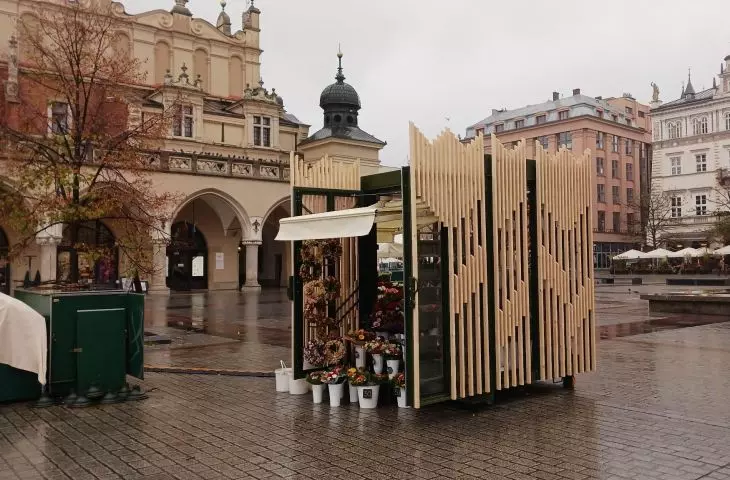Are Krakow's florists still waiting for a miracle? If the miracle is to be new stands, then perhaps the wait was not worth it. The Cracow City Hall is testing a prototype modular solution in the form of a pavilion, which we can admire in the market for a few days. The stand stands out, but is it a good thing?
There is no Krakow market without florists, who have become a permanent part of the cultural landscape of the Old Town. In the northeastern part of the market, right next to the "Adas" and the Cloth Hall, for years Krakow's florists have been selling colorful bouquets. It was they who were captured by Andrzej Sikorowski in one of his most famous songs, in which he warns, in Cracovian fashion, against restoring the city's status as a capital. The presence of florists is undeniable and unquestionable for this part of the city. Flowers can be bought whether the streets are cut by a sharp frost or hot heat is pouring from the sky.
The CityCouncil decided to make things easier for florists by introducing a new modular stand to protect against extreme weather conditions, while being an aesthetic solution - one that does not stand out in the landscape of the historic city.
Umbrellas, however, do not provide flower sellers with adequate protection during inclement weather, so we decided to develop a stand that - referring to the context of the space and in accordance with current conservation and planning regulations - will allow florists to work for most of the year. Over the next few months, the stand will be tested, allowing it to be refined and then applied to all flower outlets in the market. We hope that both residents and our guests will like the new form of stands and that it will allow florists to work in dignified and safe conditions," stresses Katarzyna Olesiak, director of the Department of Culture and National Heritage at the Cracow City Hall.
However, the project raises controversy, which cannot be ignored.
Visualizations of the city, already show the pavilions after full introduction
© Press materials of the Office of the City of Krakow
starting with the project
The project was created by the LATALAdesign studio. As the press release reads, the design was inspired by the goblets of an open leaf, while referring to designs that would have been developed more than a century ago "by the leading artists of Krakow's workshops." The pavilions were made of polycarbonate and wooden fins. Instead of flower cups, one could see inspiration from the attics of tenement houses and cloth halls, only not entirely successful.
What rejects most in the new form is, above all, the massiveness of the lump. Green boxes, old ripped-off tops, and even the yellow umbrellas with the logo of a well-known radio station, replaced some time ago, whose aesthetic effect was rather meager, did not stand out like these pavilions. The cumbersome form, in addition to being overly elaborate relative to what was here before, rejects it. In particular, the umbrellas and boxes tucked away for the evening did not even introduce half the cognitive dissonance that the pavilions will do. Above all, the form could have been smaller, blending more into the landscape.
Of course, one can ponder how to sensibly replace the existing florist stands so that they create more comfort for those working there. It would be worth starting with how to blend the pavilions into the northeastern frontage of the market, and refer to those patchwork stands that still stand there, but are to be replaced. It would also be important to discuss how to replace them so that comfort is maximized and interference is minimized. The opinions of all florists should be awaited, for the post will be tested on a rotating basis.
the last bastion of the city
Thephenomenon of florists in the old city is another one that is very often overlooked. The stands offering flowers are also the last real city-forming element in the old city center, created by the residents and dedicated primarily to the residents. Krakow's Old Town has not been a real residential area for years. The resident population has been steadily declining since the 1990s, and there are fewer and fewer places outside the university units where Cracovians can feel at home. The Cloth Hall area, dictated primarily by the phenomenon of tourism and overtourism, the most visible effect of which was the closure of the iconic Ars cinema for Cracovians, in whose place a hotel sprang up.
Of course, in many respects the Old Town has been freed from the shackles of mercantilism - when passing through Florianska Street, we are no longer attacked by advertisements in the form of hanging jeans, which tall people have to watch out for. No one gets the idea anymore about the advertising banners that were placed on the Cloth Hall almost two decades ago, which led to interference with the historic building. The excessive baggage of grandfathering was tempered by a landscape resolution.
The florists, therefore, must also be looked upon as the last bastion of city-making. Their stands may not have fit on a postcard of Krakow, but like nothing else they reflected what the old city was, a place full of life, with all its shortcomings. Much more so than museums of mirrors, candy stores or nouveau riche elegance.
new pavilions against the backdrop of the clothiers
photo by Wiktor Bochenek




















